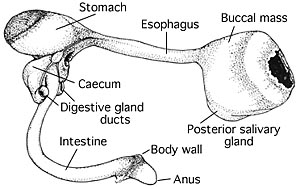- Digestive system
- Digestive tract lies in a single plane (i.e., no loops or lateral bends of the intestine).
- Obvious crop absent.
- Caecum exhibits no spiraling.
- Esophagus and dorsal side of stomach with heavy purple pigment; intestine unpigmented.
- Reduced radula present.
 Click on an image to view larger version & data in a new window
Click on an image to view larger version & data in a new window
Figure. Digestive system of C. murrayi. Drawing modified from Aldred et al., 1983.
 Click on an image to view larger version & data in a new window
Click on an image to view larger version & data in a new window
Figure. Longitudinal section through the buccal mass of C. murrayi. Unlike the situation in incirrate octopods, the anterior salivary glands are embedded within the buccal mass and the posterior salivary gland (only a single one is present) instead of lying posterior to the cephalic cartilage, rest on and is partially embedded in the buccal mass. Drawing modified from Aldred et al., 1983.
- Female reproductive system
- Largest egg found in the oviducts was 14 x 8.9 mm.
- Male reproductive system
- Spermatophore glands highly convoluted.
- Accessory glands form a compact unit.
- Penis small.
- Shell
- The butterfly-shaped shell is drawn from a dorsal view (left). The position of the shell in the octopod is indicated in the dorsal view drawn (right) of the head, body and fins in which the dorsal margins of the saddle and wings can be seen (colored red).
 Click on an image to view larger version & data in a new window
Click on an image to view larger version & data in a new window

Figure. The shell of C. murrayi, 660 mm TL, male. Left - Dorsal view of shell. Right - Dorsal view of head, body and arm bases. The red lines approximately mark the dorsal-most edges of the shell wings. Drawings from Aldred et al., 1983.
- Measurements and counts.
| Sex | Female | Male | Female | Male, immature | Male, immature |
| Mantle length | 220 | 155 | 130 | 105 | 21 |
| Total length | 940 | 660 | 560 | 535 | 67 |
| Posterior body to fin midpoint | 95 | 86 | 65 | 52 | - |
| Fin length | 210 | 110 | 115 | 114 | 23 |
| fin width | 95 | 65 | 78 | 50 | 11 |
| Head width | - | 72 | 69 | 50 | 8 |
| Eye diameter | - | 17 | 13 | 12 | 1.6 |
| Arm I, length | 685/685 | 465/445 | 420/430 | 400/405 | -/42 |
| Arm II, length | -/735 | 480/525 | 420/425 | 395/385 | 40/42 |
| Arm III, length | -/- | 480/510 | 420/430 | 395/385 | 41/40 |
| Arm IV, length | 650/670 | 470/470 | 420/420 | 425/400 | -/- |
| Arm I, sucker number | -/- | 36/38 | -/- | -/- | -/- |
| Arm II, sucker number | -/- | 37/38 | -/- | -/58 | -/- |
| Arm III, sucker number | -/- | 38/38 | -/- | 58/58 | -/- |
| Arm IV, sucker number | -/- | 36/38 | -/- | 62/58 | -/- |
| Gill length | 33 | 12 | 16 | 12.5 | 2.4 |
| Gill width | 25 | 10 | 12 | 10.5 | 1.4 |
| Gill lamellae/demibranch | 9 | 7 | 7 | 8 | 9 |
| Capture latitude | 20 10'N | 43º 34'N | 20º 07'N | 49º 49'N | 49º 49'N |
| Capture longitude | 21 10'W | 12º 58'W | 21º 46'W | 14º 06'W | 14º 06'W |
These measurements are taken from Aldred, et al., 1983.
Comments
The above description is taken from Aldred, et al., 1983. The shape and number of radular teeth have not been described. The presence of a radula was detected from histological sections (Aldred, et al. , 1983). The proximal portion of the oviducal gland had sperm packets indicating that this gland, as in incirrates, is a spermatheca in addition to its other functions.






 Go to quick links
Go to quick search
Go to navigation for this section of the ToL site
Go to detailed links for the ToL site
Go to quick links
Go to quick search
Go to navigation for this section of the ToL site
Go to detailed links for the ToL site